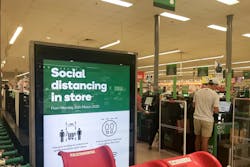We have all watched how the spread of COVID-19 has turned our world upside down this year. As retailers, airports, healthcare facilities and other businesses scramble to implement new norms of operation, they are looking for any tools that can help them overcome the enormous challenges they face.
What many are quickly discovering is that they already have a powerful tool in place: their physical security system. The same technology they use for surveillance, loss prevention and access control – the same operational intelligence they gather to help improve everything from workflow and inventory control to marketing, staff training and customer service – can also help them comply with pandemic safety guidelines, protect the health of employees and customers, and ultimately reopen for business and stay open.
If we have learned anything from the pandemic, it is that humans always find ways to adapt. While the road back to “normal” will probably have many turns and twists – and may never recapture exactly the way it used to be – inventive use of technology along with common sense best practices like social distancing, masking and frequent hand washing can move us closer to that goal.
IP security technologies have proven to be valuable in this regard, as they can be easily adapted to provide innovative solutions to problems posed by efforts to curb the spread of COVID-19.
Hands-Free Door Operation via Video Intercom
Door handles and keypad entry systems are prime surfaces for spreading the virus. To create more hygienic access control, businesses are turning their touch door entry systems into touch-free ones with a mobile app. The mobile app authenticates the user remotely, allowing them to open the door with aSome businesses are taking cleanliness a step further, using facial recognition technology to provide employees with keyless access to specific areas within the property, including cash rooms, lockers, cabinets, etc. When an employee approaches a location and stares into the video intercom camera, the system identifies them from the facial recognition database, checks their credentials and automatically trips the door lock.
Other businesses are opting to use a QR code that can be downloaded to a smartphone and scanned by the intercom. This option can be used for visitor as well. Much like with facial recognition, if the individual presents the correct QR code for that location, the system automatically unlocks the door and logs the interaction for future audit.
Audio-Based Reminders and Warnings
Intelligent audio systems are great for triggered announcements – whether warning trespassers and shoplifters, promoting sales, or even telling customers when another checkout line has opened.
In the COVID era, they are great vehicles for communicating important health information to people entering the building. What makes these systems especially useful is that messages can be broadcast live or on a fixed schedule, aired in specific zones or across an entire property or chain of properties.
For example, some businesses deploy IP speakers with built-in PIR sensors that detect if someone is approaching an area. When that happens, the technology automatically triggers a prerecorded message telling the individual to put on a face mask and use the provided hand sanitizer before entering. Once inside the building, a periodically repeating message could remind them to maintain social distancing.
To reinforce social distancing at the checkout line, some retailers are integrating their speaker systems with surveillance cameras equipped with crossline detection software. If the analytic senses a customer approaching too closely to the person in front of them, it triggers a targeted message requesting the customer to step back.
Occupancy Control Analytics
As we have seen in the news, crowds can be a petri dish for COVID-19. In an effort flatten the curve, local governments have been issuing occupancy limitsPreviously, they would have used the analytics to measure occupancy trends to help them optimizing workforce planning. They might even have integrated the application with their building management system to optimize HVAC system usage and reduce energy consumption. Now, they are also using the analytic in real-time to count the number of people currently on premises and trigger an alert when the tally reaches government recommended capacity. This ensures that the business remains compliant with community COVID-19 guidelines and is permitted to keep its doors open.
Remote Access Limits Risk Exposure
Remote access has long been a benefit of IP-based security systems; COVID-19 has just raised its use to new heights as a means of limiting exposure to the virus. Here are some real-world examples:
Hospitals: Many are monitoring patient vital signs remotely through in-room video cameras and integrated telemetry systems, greatly reducing the frequency of in-person encounters between patients and medical staff.
Systems Integrators: Many of your fellow integrators are health monitoring customer security systems through a secure network connection from the safety of their office, automating updates and the latest cyber protections remotely, and thereby keeping site visits to a minimum.
Teleconferencing: To avoid the constrictions of pre- and post-travel quarantine, there has been a significant uptick in companies conducting business online. In lieu of traveling to locations to hold meetings or training classes, more organizations are opting for teleconferencing.
They are investing in broadcast-quality cameras to create professional-looking content for e-learning, conducting interactive seminars, and posting video instruction directly to major streaming platforms for students to access remotely. These alternatives not only reduce exposure to the virus, they help companies significantly reduce travel expenses and improve their carbon footprint.
Entertainment venues: These business owners are using IP technology to find creative ways to engage audiences despite their venues being closed or only permitted extremely limited in-person attendance. Some are combining their patrons’ own online audio and video conferencing tools with livestreaming technology to create a more immersive experience. Using a pay-per-view model, they are keeping their venues afloat until they can open their doors and return to business as usual.
Temperature Screening – A Caveat about Thermal
As a precaution against introducing the virus to a facility, some places take a person’s temperature before they are allowed into the building. This has led to speculation that thermal imaging cameras might be used for COVID-19 detection.
While it is true that under specific conditions some thermal cameras are capable of precise temperature measurements, at this point in time they are not designed for the specific intention of human fever detection, nor the diagnosis, mitigation or prevention of disease or health conditions. Furthermore, they have not been approved by the US Food and Drug Administration for this particular use.
Editor’s Note: Read more about acceptable uses for thermal on page 40.
Fredrik Nilsson is VP of the Americas for Axis Communications, and is the author of “Intelligent Network Video: Understanding Modern Video Surveillance Systems” published by CRC Press and now in its second edition. Request more info about Axis at www.securityinfowatch.com/10212966.





